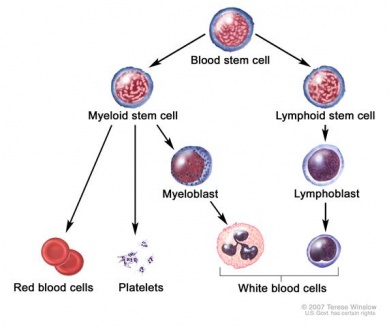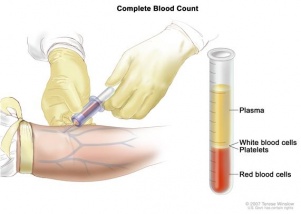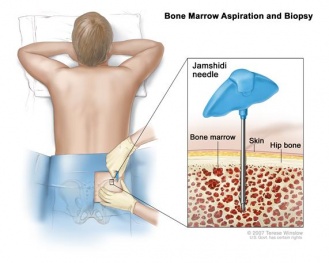Acute Myeloid Leukemia
Original Editors - Kevin Mooney & Erik Rice from Bellarmine University's Pathophysiology of Complex Patient Problems project.
Top Contributors - Kevin Mooney, Erik Rice, Lucinda hampton, Elaine Lonnemann, Vidya Acharya, Kim Jackson, Shaimaa Eldib, WikiSysop, Wendy Walker, George Prudden and Sarah Haerinck
Definition/Description[edit | edit source]
Acute Myeloid Leukemia (AML) is a type of cancer involving the blood and bone marrow. The main cell involved in this disorder is myeloid stem cells which can become either red blood cells, white blood cells, or platelets. In this disorder, Myeloid stem cells become a type of immature white blood cell called myeloblasts. These myeloblasts never become healthy white blood cells. Abnormal red blood cells, white blood cells, or platelets begin to crowd in the bone marrow to prevent healthy cells from forming.[1]
Prevalence[edit | edit source]
Acute Myeloid Leukemia is the most common leukemia in adults, comprising 80% of adult acute leukemias. The other 20% of AML patients are children. The incidence of AML increases with each decade of life with the median age of onset at 63 years old. People over the age of 70 are 12 times more likely to develop AML. Acute Myeloid Leukemia remains a rare condition with 12,000 new cases per year.[2]
Characteristics/Clinical Presentation[edit | edit source]
Initial clinical presentations of AML are related to pancytopenia, the reduction of all cell counts, reflecting the leukemic cell replacement of bone marrow. These signs and symptoms include:
- Infections due to lack of neutrophils
- Increased bleeding secondary to platelet deficiency
- Bleeding due to minor trauma, bleeding of the gums, mid-cycle menstrual bleeding, or heavy bleeding with menstruation
- Petechiae (small purplish spots caused by intradermal bleeding)
- Fatigue, loss of energy, and shortness of breath upon exertion due to low red blood cell count (anemia).
- Leukemia cutis (multiple purplish papules or diffuse rash)
- Splenomegaly occurs in 50% of patients
- Bone discomfort (especially in ribs, sternum, and tibia)
- Older adults may experience delirium, progressive weakness, and pallor.[2]
Associated Co-morbidities[edit | edit source]
add text here
Medications[edit | edit source]
Medications used to treat AML include:
- Chemotherapy drugs (most common)- Cytarabine (cytosine arabinoside) and anthracycline drugs such as daunorubicin, idarubicin, and mitoxantrone
- Other chemotherapy drugs- Methotrexate, hydroxyurea, cladribine, fludarabine, and topotecan
- ATRA- A form of Vitamin A
- Arsenic Trioxide
- Corticosteroid drugs- Prednisone and dexamethasone[3][1]
Diagnostic Tests/Lab Tests/Lab Values[edit | edit source]
Diagnostic tests for AML include:
- History and Physical Examination
- Blood Test: Tests of patients with AML will commonly reveal increased leukocyte count initially with excessive immature cells as well as low red blood cell and platelet counts.
- Bone marrow biopsy and aspiration: The removal of bone marrow, blood, and bone will be looked at by the pathologist under a microscope for signs of cancer.
- Immunophenotyping: It is the process used to determine the subtype of AML by comparing the cancer cells to normal cells in the immune system. [1][2]
Etiology/Causes[edit | edit source]
Although the exact causes of AML are unknown, there are many risk factors associated with AML including:
- Smoking
- Chemical exposure (especially long term exposure to high levels of benzene)
- Cancer treatment in the form of chemotherapy drugs called alkylating agents and platinum agents
- Radiation exposure
- Blood disorders- polycythemia vera, essential thrombocythemia, and idiopathic myelofibrosis
- Genetic Syndromes- Fanconi anemia, Bloom syndrome, Ataxia-telangiectasia, Blackfan-diamond syndrome, Schwachman syndrome, Li-Fraumeni syndrome, Neurofibromatosis I, Kostmann syndrome, Down syndrome, and Trisomy 8
- Family history of a close relative with AML
- Male gender [4]
Systemic Involvement[edit | edit source]
add text here
Medical Management (current best evidence)[edit | edit source]
add text here
Physical Therapy Management (current best evidence)[edit | edit source]
add text here
Alternative/Holistic Management (current best evidence)[edit | edit source]
Alternative treatments have been unsuccessful in treating AML, but some alternative treatments may complement traditional approaches to help relieve signs and symptoms of cancer and cancer treatments. These alternative approaches include:
- Acupuncture
- Aromatherapy
- Massage
- Meditation
- Relaxation exercises[5]
Differential Diagnosis[edit | edit source]
add text here
Case Reports/ Case Studies[edit | edit source]
add links to case studies here (case studies should be added on new pages using the case study template)
Resources
[edit | edit source]
add appropriate resources here
Recent Related Research (from Pubmed)[edit | edit source]
see tutorial on Adding PubMed Feed
Failed to load RSS feed from http://www.ncbi.nlm.nih.gov/entrez/eutils/erss.cgi?rss_guid=1r51yhURGNpui6KpvieR76wn0CeGPQIrRn8zYLQXi-zS4mEUXy|charset=UTF-8|short|max=10: Error parsing XML for RSS
References[edit | edit source]
see adding references tutorial.
- ↑ 1.0 1.1 1.2 National Cancer Institute. Adult Acute Myeloid Leukemia Treatment. National Cancer Institute at the National Institute of Health. December 26, 2013. Available at http://www.cancer.gov/cancertopics/pdq/treatment/adultAML/Patient/page1, Accessed March 11, 2014
- ↑ 2.0 2.1 2.2 Goodman CC, Fuller KS: Pathology: implications for the physical therapist, ed 3, Philadelphia, 2009, WB Saunders.
- ↑ American Cancer Society. Chemotherapy for acute myeloid leukemia. American Cancer Society. February 7, 2014. Available at http://www.cancer.org/cancer/leukemia-acutemyeloidaml/detailedguide/leukemia-acute-myeloid-myelogenous-treating-chemotherapy. Accessed March 17, 2014
- ↑ American Cancer Society. What are the risk factors for acute myeloid leukemia? American Cancer Society. February 7, 2014. Available at http://www.cancer.org/cancer/leukemia-acutemyeloidaml/detailedguide/leukemia-acute-myeloid-myelogenous-risk-factors. Accessed March 17, 2014
- ↑ Mayo Clinic Staff.Diseases and conditions acute myelogenous leukemia: Alternative medicine. Mayo Clinic. September 15, 2012. Available at http://www.mayoclinic.org/diseases-conditions/acute-myelogenous-leukemia/basics/alternative-medicine/con-20043431. Accessed March 17, 2014.









